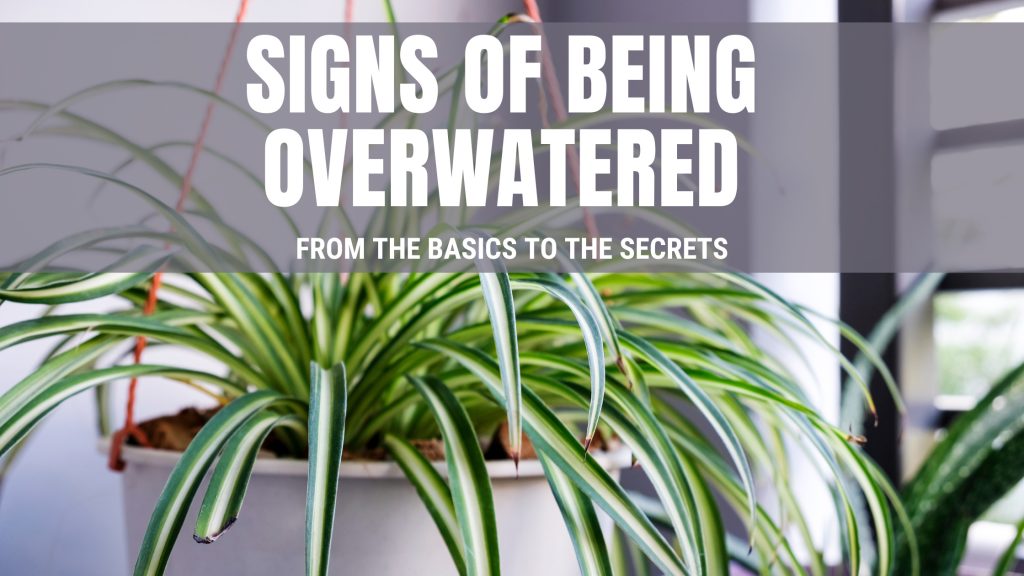Overwatered spider plants are a common problem for homeowners in the summertime. That is why you need to know how to revive an overwatered Spider plant.
Spider plants are hardy and can survive minor flooding, but when water hits their soil level too often, it can lead to salt build-up and die back.
You can do several things to help revive an overwatered spider plant.
- First, try drenching it with cool water (not cold). It may seem counter-intuitive but it helps with a temperature change.
- Second, use a towel to dry the soil around the base of the plant.
- Finally, mix 1 part perlite with 3 parts water in a new pot for better drainage.
Remove the plant from its container and place it in a cool, shady location. To avoid drowning the spider plant, repot it in a new container with fresh potting soil. Once the spider plant has recovered, move it to a location where it can receive bright indirect light.
Table of Contents
What Are The Signs Of An Overwatered Spider Plant?
If you think your spider plant is overwatered, there are a few signs to look for. The first is yellowing or browning leaves. This is a sign that the roots are not getting enough oxygen and are starting to rot.
You may also see wilting, drooping leaves, or leaves falling off the plant. These are all signs that your spider plant is getting too much water.
If you see any of these signs, you must take action immediately.
Stop watering your plant and let the soil dry out completely. Once the soil has dried out, you can resume watering, but you should do so less frequently and more deeply so that the roots have time to dry out.
If you continue to water your plant too often, you may end up causing even more damage.
What Is The Best Way To Revive An Overwatered Spider Plant?
You must first assess the damage if you have an overwatered spider plant. If the leaves are wilted and discolored, it is likely that they are beyond repair and will need to be cut off.
Discolored or wilted leaves should be removed, preferably close to the plant’s root system. Once you have removed all the damaged leaves, look at the roots. If they are mushy or smell rotten, they must be cut away.
Remove any excessively soft or discolored roots, cutting them as close to the plant’s base as possible.

After removing all the damaged leaves and roots is time to repot your spider plant. Be sure to use a well-draining potting mix and a pot with drainage holes. Water your spider plant lightly, then allow it to drain completely before putting it back in its pot.
Give your spider plant time to recover by positioning it in indirect, bright light. With proper care, your spider plant should soon return to its healthy self!
How Often Should You Water A Spider Plant?
Spider plants can be one of the easiest houseplants to care for, which is why they’re so popular. But even easy-to-care-for plants need a little attention from time to time, and spider plant watering frequency is a frequently asked question.
Several factors, including the size of your plant, the pot it is in, and the climate in which you live, influence the answer to this question. In general, spider plants like to be kept moist but not wet.
The best way to water your spider plant is to give it a good soaking once a week and then allow the soil to dry out completely before watering again.
If you live in a hot or sunny climate, you may need to water your spider plant more frequently. Similarly, you’ll need to water your plant more regularly if it’s in a small pot rather than a large one.
And finally, if your plant is growing lots of new babies (also called offsets or pups), it will also need more water than usual.
So how do you know if your spider plant needs water? The best method is to probe the ground with a finger. If it feels dry an inch or two below the surface, it’s time to water. If it feels moist, wait another day or two before watering again.
What Are Some Common Mistakes People Make When Watering Spider Plants?
Overwatering spider plants is a standard error that many people make. Spider plants are susceptible to too much water and will start to yellow and wilt if they are overwatered. If you think your spider plant is overwatered, try to allow the soil to dry out completely before watering it again.
A second common error is providing insufficient light for spider plants. A light that is bright but not direct is ideal for spider plants. If your spider plant doesn’t get enough sunlight, its leaves will turn brown and crispy, and it will produce fewer leaves overall. Leaves in poor condition will not allow the plant to absorb water in a sufficient manner and could lead to excess water in the pot.
How Can You Prevent Your Spider Plant From Being Overwatered In The Future?
You can do a few things to prevent your spider plant from being overwatered in the future.
- First, ensure you only water your plant when the soil is dry. You can stick your finger in the soil to check if it’s moist or not. If it is, then wait a few more days before watering again.
- Second, always use a well-draining pot for your spider plant. By doing so, you can guarantee that any standing water around your plant’s roots will be able to escape.
- Finally, consider getting a self-watering pot that will help regulate the amount of water your plant gets automatically.
Following these guidelines will help you avoid overwatering your spider plant and keep it looking its best.
Conclusion
The frequency with which spider plants are kept as houseplants was a topic that was addressed in this particular article. Because they do not require a great deal of maintenance, spider plants are frequently disregarded by their owners.
It is possible that you overwatered your plant, which is a common problem; however, this does not necessarily mean that the plant will perish as a result of this.
Simply keep an eye out for signs such as leaves that have changed color, and before adding any more water, wait for the soil to become completely dry.
You will be able to save a Spider plant that has been overwatered and prevent this problem from occurring again in the future if you take the advice that is provided in this blog post and apply it.
Recent Posts
Have you found yourself wondering, 'why is my bamboo growing so slow?' Despite the fact that bamboo plants are remarkably fast-growing, it can sometimes take months (or even years!) to see any signs...
Miracle-Gro is a huge help when you are trying to get decent yields out of your plants or if you want them to thrive. However, you may have noticed that a single dose of fertilizer does little to...
